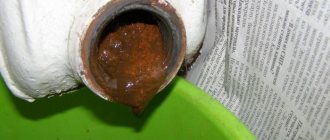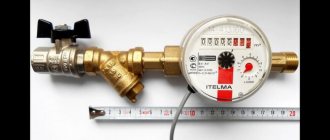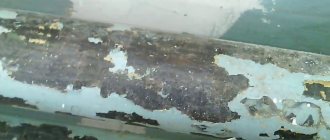Water hammer is called the most common cause of emergency situations in pipelines through which any liquid circulates. Water hammer in a water supply system is a sharp and strong increase in water pressure, provoked by a rapid change in the speed of its flow. The first signs of this phenomenon are knocks and clicks, dull knocks, the appearance of leaks at the junction of elements of the plumbing system or leaking taps. The result of the impact of pressure surges is a violation of the tightness with destruction of the pipeline.
A crack in the pipeline caused by constant water hammer. Source uerria.witclub.info
Causes
Knowing what water hammer is in a water supply system, it is easy to identify the reasons for its occurrence. In this case, it is necessary to distinguish between negative and positive hydraulic shocks. The first occurs when water with high pressure enters a section of a pipeline with a sharply reduced liquid pressure. The second, more dangerous in their consequences, arise when pressure increases due to a rapid abrupt increase in the speed of its flow or, conversely, a stop. In practice this happens due to:
- sudden closure of valves or taps;
- turning on or off pumping equipment (including situations associated with a power outage);
- air jams;
- availability of pipes of different diameters.
It is worth noting that with the spread of ball designs of valves and faucets, the wear of water pipelines due to pressure shock has become more significant. Unlike the classic screw design, the ball design requires significantly less time for opening/closing shut-off valves. To do this, just turn the handle 90 degrees with one movement of your hand. And this, of course, is faster than several turns of the valve.
Ball and valve shut-off valves for hot and cold water supply pipelines Source nurai-invest.kz
The likelihood of water hammer is higher the longer the pipeline and the greater the potential volume of liquid that can collect in front of the shut-off valves or at the narrowing of the pipes.
See also: Catalog of companies that specialize in the calculation and installation of water supply and sewerage systems.
How to install
Miss Clean magazine strongly recommends entrusting any work with pipes, especially with risers, to specialists. They will carry out the installation efficiently and quickly.
General rules:
- the shock absorber is installed on a certain length of pipe (for example, under the ceiling of each odd-numbered floor);
- the best option is when the compensator is located in front of the valve, faucet, valve of household appliances, faucets, and other consumers;
- it is also permissible to place the compensator after the collector outlets (i.e. after the check valves) in the apartment (see below photo from S. Savitsky’s blog “Ideas for Repair”);
- if a gearbox is placed, the compensator follows it;
- the compensator must be located directly on the pipe or on a corner transition, and not on its dead-end branch (see photo below);
- the shunt is installed strictly in the direction of water flow;
- the regulator or valve is placed near the controller and connected to it.
Okay, we figured out the pipes and risers. What to do if the house has an electric storage water heater or a gas water heater? The former are usually equipped with their own safety valves. In the case of a “column” or any other instantaneous water heater, the compensator should be placed after the unit - this will extend the life of its hoses and seals.
Consequences of water hammer
Any incidents with the water supply are associated not only with material damage to the pipeline itself, but also with the costs of eliminating the consequences of water exposure to nearby objects. This is especially aggravated for pipelines with hot water and those under high pressure. In these situations, there is even a danger to the health and life of people and pets. They may be scalded or injured. In particular, this negative phenomenon may be followed by the following:
- destruction of pipe lines;
- flooding of residential, administrative and utility premises;
- failure of pumping equipment and shut-off valves;
- damage to furniture, household appliances, computers and the like;
- interruption of water supply;
- destruction of structures of buildings and structures (especially in winter, due to the force of expansion when moisture freezes);
- interruption of electrical supply;
- fires due to short circuit of electrical wiring.
Danger of consequences of damage to heating and water supply due to water hammer Source formp3life.ru
Accidents on highway networks can cause traffic congestion; in winter, icy conditions caused by gusts usually completely block the movement of cars for some time.
Manufacturers, characteristics, prices
It is best to buy a water hammer compensator from well-known companies. This is not the area where it is appropriate to save money. The most popular are several companies:
- FAR. The compensator from this company is without a membrane, with a spring and a locking disc. Connecting thread 1/2″, maximum pressure 50 Bar, nominal pressure 10 Bar. Withstands temperatures up to 100°C. Price from 30 $.
- Uni Fitt. The same design with a spring-loaded disk. There are two body options: brass and nickel plated brass. Connection 1/2 inch. Maximum temperature 90°C, nominal pressure - 10 Bar, peak pressure - 20 Bar. The length of the protected pipeline is 10 m. Price from $15.
The same models are sold at different prices in different stores - Valtec (Valtek). This is a membrane type hydraulic shock absorber. There are models connected through a small ball valve with a pressure gauge. If necessary, open the ball valve and check the pressure in the compensator. The pressure in the chamber is 3.5 Bar, the maximum operating pressure is 10 Bar, the maximum compensated pressure is 20 Bar. Price from $25.
- CALEFFI (Caleffi). This company produces disk compensators. There are regular ones - with a 1/2″ connection, and there are 3/8″ ones for the sink. The parameters can be called good: the working pressure is no more than 10 Bar, they can compensate up to 40 Bar (for washing up to 30 Bar).
There are other companies, but they are not so popular. some due to being overpriced, others have not gained trust. At least for now.
Prevention and protection
Prevention and protection against water hammer is based on two things. This is correct operation and direct protection against water hammer in the water supply system. The first primarily comes down to minimizing cases of instantaneous changes in flow speed due to incorrect human actions. To do this, all switching on and off of the pipeline must be done smoothly, ensuring a uniform change in pressure over a certain period of time. Preventive measures also include checking the system for leaks, regularly replacing and cleaning filters, and checking the functionality of water supply elements.
Other ways to combat water hammer
One of the possible options for neutralizing water hammer has already been voiced - close the taps smoothly. But this is not a panacea, and it is inconvenient in our fast-paced times. And there are also household appliances, you can’t teach them. Although, some manufacturers take this point into account, and the latest models are made with a valve that smoothly shuts off the water. This is why compensators and neutralizers are becoming so popular.
You can combat water hammer using other methods:
- When installing or reconstructing water supply or heating systems, insert a piece of elastic pipe in front of the source of water hammer. This is reinforced heat-resistant rubber or PPS plastic. The length of the elastic insert is 20-40 cm. The longer the pipe, the longer the insert.
- Purchase of household appliances and shut-off and control valves with smooth valve movement. If we talk about heating, problems with warm water floors are often observed. Not all servos operate smoothly when closing the flow. The solution is to install thermostats/thermostats with a smooth piston stroke.
- Use pumps with soft start and stop.
Water hammer is a truly dangerous thing for a closed system. He breaks radiators and bursts pipes. To avoid problems, it is better to think through control measures in advance. If everything is already working, but problems arise, the smartest and easiest way is to install compensators. Yes, they are not cheap, but repairs will cost more.
Technical means of protection
The system must be maximally protected from rash human actions, improper operation and untimely and incomplete maintenance. To achieve this, there are a number of technical solutions to minimize the consequences of fluid pressure surges in water supply and heating networks and prevent their occurrence.
Pipe replacement
To do this, it is necessary to inspect the entire pipeline; old steel pipes should be replaced with modern ones made of polymer materials. They are more reliable, practically resistant to corrosion and last longer. In this case, pipes must be selected taking into account operating conditions (pressure and temperature in the network) with a small margin in parameters. To reduce the flow rate, it is advisable to choose products with the maximum possible diameter for the pressure. Find a middle ground.
Modern reliable pipes and connecting elements made of polymer materials Source santehnika-nk.ru
Replacing shut-off valves
Replacing ball valves with valve valves can be called a return to the past, but this will avoid sudden pressure changes regardless of how the shut-off valves open and close. It is not necessary to change all locking devices; you can limit yourself to only those that are critical to the system.
Varieties
There are several types of current device classifications. The most practical is considered to be grouping according to the types of membranes used. Today, almost all devices are produced with a diaphragm membrane. The cylinder is non-separable, made of durable steel. Usually consists of two hemispheres welded together. The membrane is mounted in such a way that the cavity of the tank is divided into two parts. The connecting pipe remains in one part, and the spool in the other.
The balloon membrane must be replaced. But modern materials are able to withstand increased loads for quite a long time without loss of integrity and elasticity, so the need to replace the membrane has practically disappeared. The reservoir for the balloon membrane is dismountable. The water is contained in a rubber chamber and does not come into contact with the inner walls of the tank. The spherical membrane is practically not used today; it is considered a rarity.
Design of safety valves
Depending on the operating conditions and purpose of the valve, they may differ in a number of parameters: standard size;
- body material (cast iron, bronze);
- material of the shut-off membrane (natural rubber, reinforced nitrile rubber);
- type of connection to the body (flange, threaded, quick-release-victaulik);
The design orientation of the rod and diaphragm can be:
- vertical – equipment of series 100 and 300;
- inclined – series 500.
Water hammer when filling the washing machine with water
Latest questions
Angelika Washing machines LG
New washing machine in the bath. Water hammer when filling the washing machine with water. When there was an old car, there was no such impact. There is also no water hammer in the shower stall. What is the reason?
This is how LG's intake valves work. jerkily.
Good morning, check the motor brushes
Strong water pressure
Most likely the problem is in the valves or in the control module, start with the valves and pump, if they are in order, then it is worth checking the active components as part of the control module.
At the beginning of the fill, the valves in the LG turn on approximately 3-4 times for 5 seconds, then a full supply of water occurs. As a tip, reduce the water supply pressure to the machine. She's fine.
There is no problem, everything works correctly for this model.
pipelines made of polymer pipes and the presence of flexible connections negates all hypothetical harm from water hammer
Similar questions
Washing without running water more than 6 months ago LG washing machines
Hello. LG washing machine. I don’t know if you can help me, this is probably not what you do, but I’ll try to take the risk anyway. U.
Vibration when spinning a washing machine more than 6 months ago Washing machines LG F12A8HDS5
Hello. During the spin cycle, the LG F12A8HDS5 washing machine began to vibrate strongly. Where to begin? Replace shock absorbers or immediately.
What does the crossed out key mean more than a year ago LG washing machines
So I’m interested to know what the little key means?
Source
Features of installation of compensating devices
The heating system and water supply systems in residential buildings are equipped with compensators according to the design. Compensators are secured to the main structure by welding.
The devices are installed when the pipeline system is not working, when there is no pressure and no transported liquid. During installation, ensure that the pipe and compensator are aligned in order to prevent radial loads on the system during operation.
The presence of this type of load entails jamming and further breakdown of the moving elements of the product.
The heating system is equipped with compensators on straight sections of the pipeline, and when all sections are attached to fixed supports. Along with fixed supports, it is necessary to install sliding ones so as not to deform the pipeline during warm expansion. It is necessary to take into account the amount of friction at installation locations when calculating the maximum size of the pipeline area with a built-in expansion joint.
Attention! In the area where the bellows expansion joint is installed, supports or suspended structures cannot be mounted.
Hydraulic compensator device
In total, there are 2 types of hydraulic compensators, each of which is divided into 2 more subtypes: hydraulic pusher (regular or roller), hydraulic support (regular or for installation in a lever or rocker arm). The design will depend on which timing gear the part will work in tandem with: DOHC or SOHC. In general, a hydraulic compensator is a hydraulic plunger system in a non-separable metal housing. The main elements of such a system are:
- Plunger pair (plunger and bushing);
- Plunger spring;
- Check valve (usually a spring-loaded ball);
- Frame.
The installation location of hydraulic compensators depends on the type of timing belt. In the case of DOHC these are the valve head wells, and in SOHC these are the rocker arm housings. An ideally functioning compensator prevents the occurrence of gaps throughout the entire timing cycle. The prefix “hydro” is placed in the name for a reason, since the operation of the device depends on changes in engine oil pressure. It is not entirely correct to compare a hydraulic compensator with a spring, but this analogy makes sense. We suggest you familiarize yourself with the two main phases of the device’s operation:
- The timing valve is closed. Since the camshaft cam does not act on the compensator, the spring inside its housing is completely relaxed and lifts the plunger as much as possible, pressing it against the cam. In this case, the sub-plunger space is completely filled with engine oil and the lubricant pressure inside the compensator is equalized with the pressure in the oil system;
- The timing valve is open. The camshaft cam is turned towards the compensator and has maximum impact on it. The spring of the device is selected so that its force is sufficient to open the timing valve. Excess oil is then pushed back into the lubrication system.
Thanks to the presence of a correctly selected spring, the hydraulic compensator prevents the occurrence of gaps both in both of these phases, and during the transition from one phase to another, when, for example, the valve just begins to open or close. More importantly, the compensator continues to work normally even when the cams wear out and their cast length becomes shorter than normal. Simply put, the device “selects” the gap based not only on thermal expansion, but also on the wear of the timing elements.











